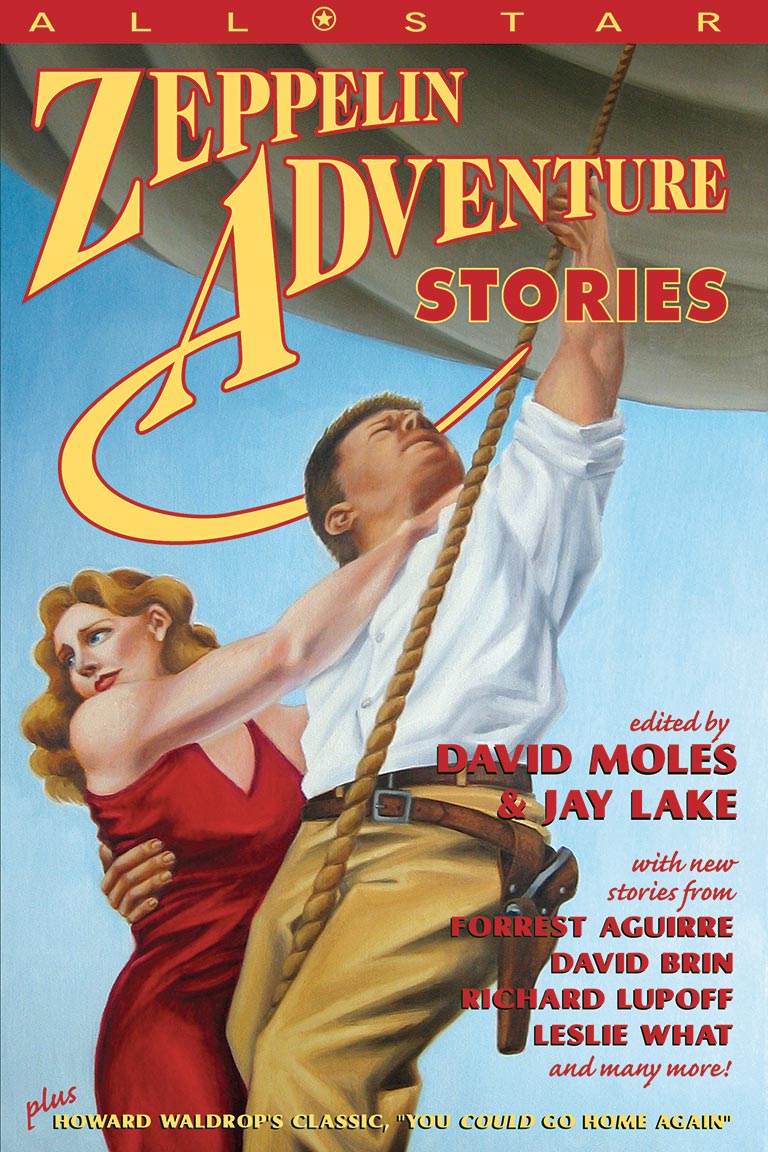
Design and illustration by Lara Kratz.
All-Star Zeppelin Adventure Stories
edited by David Moles and Jay Lake
David Moles and Jay Lake, eds. All-Star Zeppelin Adventure Stories. Wilsonville: Wheatland Press, 2004. ISBN 0-9720547-7-4.Once, and not that long ago, zeppelins were the future. The end of the Victorian era saw the fabulous and solitary flying machine imagined in Verne’s 1866 Robur le conquerant give way to the crowded commercial skies of Rudyard Kipling’s 1905 “With the Night Mail,” filled with airships of every description, from passenger liners, to tramp freighters, to tethered navigation beacons, to the swift, faithful, steadfast Night Mail of the title. It remained a plausible future, or at any rate a possible one, all through the first half of the twentieth century, before it was finally overtaken by events.
So why do zeppelins still capture the imagination today?
At a time when the future looks dark, it’s natural to turn back to a time when it looked brighter, whether to ask “What went wrong?” or merely to lose ourselves, for a little while, in the dreams of what now seems a more innocent age. From here, the view of Kipling’s tranquil, airship-filled skies (there are no wars in his future, and no government other than that provided by the light and reluctant hand of the postal service) looks very inviting.
Not all of the stories in this book are as peaceful as “With the Night Mail,” or as relaxing as a transcontinental voyage on Howard Waldrop’s U.S.I.A.S. Ticonderoga. It seems that when you offer most authors a zeppelin, their first impulse is to crash it, set fire to it, or blow it up. (Or, in one extreme case, set upon it an undersea monster that would not look out of place in a Toho film.) These are, after all, zeppelin adventure stories. But there are also any number of adventures one can have aboard a zeppelin that leave the zeppelin intact, and our authors have provided plenty of those as well. We did allow certain liberties to be taken: there is a hot-air balloon story; there is a high-altitude helium balloon story; there is even a tethered barrage balloon story. There are talking zeppelins, living zeppelins, zeppelins dead and embalmed, giant zeppelins, miniature zeppelins, real zeppelins, dream zeppelins, zeppelins of the future, zeppelins of the past—zeppelins of the imagination.
Raise the gangplank, let fall the cables and the ballast. Open the throttles on those twenty-cylinder Maybachs and bring the nose up. The skies of the future may no longer belong to zeppelins, but the skies of the imagination are open, and always will be.
“So you need me to stop the Nazis from building a death ray?”
The General’s brow creased. “I suppose you could put it that way, yes. The device will be so massive that only an airship can transport it effectively to inland targets. And they intend to begin construction on the weapon system in a matter of days.”
“You can count on me, General,” said Hugh. “Those Nazis won’t know what hit ’em.”
“Subtlety, Betcha,” the General said. “This can’t make the news. Best if the Nazis never know you were there. We don’t want anyone launching a war just yet. The last thing we need right now is another international incident.”
“I’m not afraid of the Nazis, sir—they’re a cowardly lot. I’ll do my darnedest to make sure that America won’t fall under Hitler’s tyrannical heel.”
“And I don’t mean subtle like that weapons cache you blew up in Czechoslovakia last fall—”
“We’re wasting time, General,” said Hugh. “I’d love to stay and chat, but the Nazis won’t wait.”
“All right, then,” said the General. “Oh, I almost forgot. Sally couldn’t come to see you off, but she asked me to give you this.” He handed Hugh a rubbery chew toy. “For the ferret.”
Hugh took the toy and saluted the General. “God bless America.”
Jed Hartman, “The Last of the Zeppelins”